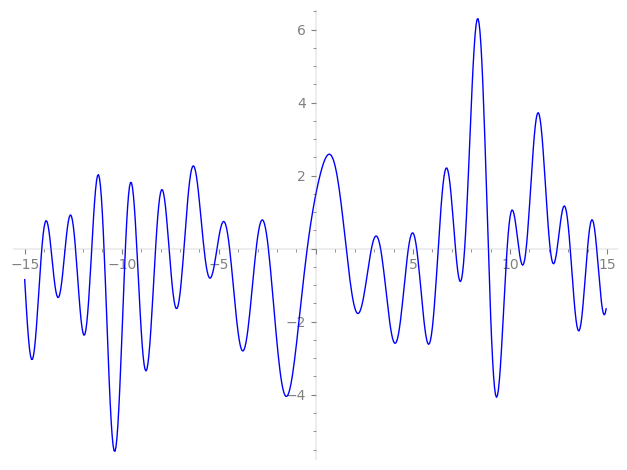| L(s) = 1 | + (0.866 + 0.5i)2-s + (0.499 + 0.866i)4-s − 1.14i·5-s + (−0.866 + 0.5i)7-s + 0.999i·8-s + (0.573 − 0.993i)10-s + (−3.84 − 2.22i)11-s + (−3.54 + 0.666i)13-s − 0.999·14-s + (−0.5 + 0.866i)16-s + (−1.35 − 2.34i)17-s + (5.68 − 3.28i)19-s + (0.993 − 0.573i)20-s + (−2.22 − 3.84i)22-s + (1.03 − 1.80i)23-s + ⋯ |
| L(s) = 1 | + (0.612 + 0.353i)2-s + (0.249 + 0.433i)4-s − 0.513i·5-s + (−0.327 + 0.188i)7-s + 0.353i·8-s + (0.181 − 0.314i)10-s + (−1.16 − 0.670i)11-s + (−0.982 + 0.184i)13-s − 0.267·14-s + (−0.125 + 0.216i)16-s + (−0.328 − 0.569i)17-s + (1.30 − 0.752i)19-s + (0.222 − 0.128i)20-s + (−0.473 − 0.820i)22-s + (0.216 − 0.375i)23-s + ⋯ |
\[\begin{aligned}\Lambda(s)=\mathstrut & 1638 ^{s/2} \, \Gamma_{\C}(s) \, L(s)\cr =\mathstrut & (0.197 + 0.980i)\, \overline{\Lambda}(2-s) \end{aligned}\]
\[\begin{aligned}\Lambda(s)=\mathstrut & 1638 ^{s/2} \, \Gamma_{\C}(s+1/2) \, L(s)\cr =\mathstrut & (0.197 + 0.980i)\, \overline{\Lambda}(1-s) \end{aligned}\]
Particular Values
| \(L(1)\) |
\(\approx\) |
\(1.501977400\) |
| \(L(\frac12)\) |
\(\approx\) |
\(1.501977400\) |
| \(L(\frac{3}{2})\) |
|
not available |
| \(L(1)\) |
|
not available |
\(L(s) = \displaystyle \prod_{p} F_p(p^{-s})^{-1} \)
| $p$ | $F_p(T)$ |
|---|
| bad | 2 | \( 1 + (-0.866 - 0.5i)T \) |
| 3 | \( 1 \) |
| 7 | \( 1 + (0.866 - 0.5i)T \) |
| 13 | \( 1 + (3.54 - 0.666i)T \) |
| good | 5 | \( 1 + 1.14iT - 5T^{2} \) |
| 11 | \( 1 + (3.84 + 2.22i)T + (5.5 + 9.52i)T^{2} \) |
| 17 | \( 1 + (1.35 + 2.34i)T + (-8.5 + 14.7i)T^{2} \) |
| 19 | \( 1 + (-5.68 + 3.28i)T + (9.5 - 16.4i)T^{2} \) |
| 23 | \( 1 + (-1.03 + 1.80i)T + (-11.5 - 19.9i)T^{2} \) |
| 29 | \( 1 + (-3.59 + 6.23i)T + (-14.5 - 25.1i)T^{2} \) |
| 31 | \( 1 + 7.90iT - 31T^{2} \) |
| 37 | \( 1 + (8.35 + 4.82i)T + (18.5 + 32.0i)T^{2} \) |
| 41 | \( 1 + (-8.22 - 4.74i)T + (20.5 + 35.5i)T^{2} \) |
| 43 | \( 1 + (1.70 + 2.94i)T + (-21.5 + 37.2i)T^{2} \) |
| 47 | \( 1 + 1.67iT - 47T^{2} \) |
| 53 | \( 1 + 13.2T + 53T^{2} \) |
| 59 | \( 1 + (0.0586 - 0.0338i)T + (29.5 - 51.0i)T^{2} \) |
| 61 | \( 1 + (4.05 + 7.01i)T + (-30.5 + 52.8i)T^{2} \) |
| 67 | \( 1 + (0.444 + 0.256i)T + (33.5 + 58.0i)T^{2} \) |
| 71 | \( 1 + (9.34 - 5.39i)T + (35.5 - 61.4i)T^{2} \) |
| 73 | \( 1 - 8.02iT - 73T^{2} \) |
| 79 | \( 1 - 10.7T + 79T^{2} \) |
| 83 | \( 1 - 15.3iT - 83T^{2} \) |
| 89 | \( 1 + (9.40 + 5.42i)T + (44.5 + 77.0i)T^{2} \) |
| 97 | \( 1 + (-1.84 + 1.06i)T + (48.5 - 84.0i)T^{2} \) |
| show more | |
| show less | |
\(L(s) = \displaystyle\prod_p \ \prod_{j=1}^{2} (1 - \alpha_{j,p}\, p^{-s})^{-1}\)
Imaginary part of the first few zeros on the critical line
−9.222753993185920884183428055263, −8.258625041493479811035079664192, −7.56170213099036195814146414923, −6.79714520526197823318391228082, −5.76367918692382597932642295912, −5.09518694053969568151115210336, −4.44560856997809434411022835240, −3.07674329524338410004465084675, −2.44773306211082300296879890891, −0.44772477620575003666346420125,
1.56385712193918364956182058835, 2.86084337402300595353017255172, 3.33151598345395100137237007469, 4.76205886921106686727842884291, 5.19071533604658852582583959620, 6.30018151005825227793457186882, 7.19055855083400127946429050085, 7.66114123560151035196146004575, 8.881760611411587958328129414420, 9.848777662180376987647422672412

